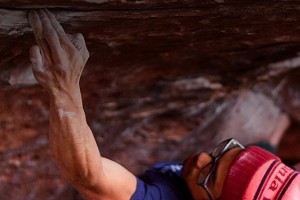
Crack gloves aren't just for softies and North Americans, says Toby Archer. Here he checks out two models currently available in the UK, Ocun's Crack Glove and the Outdoor Research Splitter.
When the question of crack gloves comes up on the UKC forums, there are invariably one or two comments along the lines of "toughen up" or "learn to jam properly". If people want to continue climbing glove- or tape-less, then good for them. But as I wear climbing shoes on my feet and use chalk to keep my hands dry, I can't get wound up about sometimes covering the back of my hand with tape or rubber for crack climbing. You do hurt your hands less as you get better at jamming, but you never stop hurting yourself completely. This is particularly true as routes get steeper and more sustained. Enter the crack glove, or tape equivalent.
"For me, the best thing about gloves or tape is that I can climb hard cracks (for me) day after day without bruising and tenderness"
A number of climbers have noted that as they get older cuts and scrapes on their hands take much longer to heal and crack gloves make sense for that reason too. Some of us might even have jobs where scabby backs of hands are either seen as unhygienic or unsightly.
For me the best thing about gloves or tape is that I can climb hard cracks (for me) day after day without the bruising and tenderness that tends to come with multiple days of crack climbing. I realized this the first time I ever taped up for climbing, in Lofoten in 2002. I think I had decided it was the thing to do anyway and had brought tape, but my climbing partner for that week, another Toby, was exceedingly well travelled and had lots of taping experience from his adventures on American granite and sandstone. I remember starting nervously up the first pitch of the direct start to Vestpillaren – 40 metres of fantastic HVS cracks – slotting my taped hand into the first hand jam and pulling. The result was a revelation: secure, pain-free and fast – no need to make micro-adjustments for comfort; the pitch flew past in a blur of karate-chop jams and I arrived at the belay swiftly, and feeling a bit less nervous about the enormity of the climb above. The next 11 pitches went well and the tape kept my hands in good order for many more crack pitches over the rest of the trip.
That first pair of tape gloves lasted a full week of daily crack climbing in the Arctic and then got taken back down south to Helsinki where I lived at the time, and used for further days on the little granite crags of Southern Finland before I finally binned them. In subsequent summers, I would make another pair on trips to north Norway, then continue to use them once home again for local cracks. I know many American climbers tape in a way that is one time only; you remove the tape at the end of the day and bin it – hence requiring huge amounts tape if you crack climb a lot – but I found reusable ones worked reasonably well even after multiple days of use. Hence if you are thinking of getting crack gloves, you might want to give tape gloves a go first – especially if you've some rolls of athletic tape lying around already. If you go down the American route of only taping for a day, your tape bill will soon make crack gloves the economic choice, but if you make them reusable (you do need to make a new wrist loop each time you use them), you will get many crack climbing days out of a £4 roll of Metolius tape.
"With gloves you put them on when you think you might want them, and take them off when you don't. This would be near impossible with tape"
So, if tape gloves are what the hard Americans all use AND are the most economical form of crack climbing hand protection, why would anyone bother with crack gloves? I would argue that for the British climber there are a number of advantages.
Firstly, all the styles of crack glove I have used are easier to put on and take off than tape. Tape gloves make a lot of sense when you are doing a multipitch route up a crack system, be that in the Californian High Sierra, Lofoten or above Chamonix. But for an evening of cragging on grit you might want some hand protection to grunt your way up some crack and then nothing but chalk to palm and smear your way up the slab next door.
With gloves you put them on when you think you might want them, and take them off when you don't. This could even be mid-pitch. A few years ago I did the Bohuslän classic, Bergkirstis Polska, and after about the first 15 metres decided my crack gloves were stopping me from getting my hands into the thin crack. With some judicious use of teeth I took the gloves off and dropped them to the ground before continuing to the top. This would be near impossible with tape gloves.
Secondly, tape gloves absorb water and then don't work as well. This might not be much of a worry at Joshua Tree but it is at Froggatt in February! For climbing through the winter in Britain, crack gloves not only resist dampness, they also offer a surprising amount of warmth to your hands. I imagine this is mainly to do with stopping heat being conducted away from the back of your hands when crack climbing. Additionally they allow firmer and hence more secure jams in green and greasy cracks during the danker months.
Thirdly, even though crack gloves are becoming more common in the UK, taping up still looks a bit, well, "Yosemite" doesn't it? If you feel self conscious about wearing crack gloves, at least it's not quite as obvious as a shiny white tape job.
So you want to try crack gloves? Good!
"For climbing through the winter in Britain, crack gloves not only resist dampness, they also offer a surprising amount of warmth"
Review
For this review I have tried out the Outdoor Research Splitter Glove and the Ocun Crack Glove. Also available in the UK, but not reviewed here, are Singing Rock Chocky Gloves. I've owned a pair of these for eight years or so and can attest to them lasting very well. They are however thicker than either the OR or Ocun versions and the wrist strap is particularly bulky – it was these gloves that stopped me getting my hands into the crack of Bergkirstis Polska. I have logged about 70 routes since starting to review the OR and Ocun models – about half in each. Additionally the gloves have been lent out to climbing partners to try. Most of those routes have been gritstone and, at my grade, that means plenty of jamming, but for testing I also wore them for several weeks for every non-jamming route too, to see if I could break the finger loops, the Velcro, or if my sweaty hands would delaminate the rubber on the gloves. Both pairs have survived well; there is a bit of delamination of one of the rubber patches on the OR gloves – perhaps 5mm on one corner which I should probably try to glue back down. Early versions of the Splitter gloves reportedly delaminated quickly and OR perhaps haven't resolved this completely. The Ocun Crack gloves look as good as new after a few months of use.
Outdoor Research Splitter Gloves £30
The first thing you notice about the Splitter gloves is how light they are. They are made from a sheet of synthetic suede that looks incredibly delicate but actually turns out to be seemingly indestructible. Onto the suede is then laminated what OR calls a "non-slip synthetic leather", although it feels more like some sort of rubber. The wrists are secured with a slim strap held down by Velcro. This works well and has never come undone when it shouldn't. The gloves are so thin I originally thought they would be more painful to use than other designs but interestingly this seems not to be the case. It appears that as long as a glove (or tape) stops our skin from being cut or abraded, then the natural padding within our hands is plenty to make hand jamming perfectly comfortable.
The finger holes on the Splitters look very thin and a number of us trying them commented that they looked like they would break, but as noted above the synthetic suede has so far seemed very tough with no problems. Additionally, OR have a famously good guarantee should the Splitters not last well; worth keeping in mind in the light of the small amount of delamination I've had on the test pair. Overall, I've been impressed with the Splitters. They are so light and scrunch up to next to nothing, they can be put in any crag pack "just in case". Additionally they could easily go in a pocket when alpine climbing, to come out for the crux crack pitch, even if they are not needed for the rest of the route.
Ocun Crack Gloves £30
Ocun, with their Crack Gloves, have produced something more meaty than the OR Splitters although it is worth noting they are thinner than Singing Rock gloves. The Crack Gloves have a rubber backing that feels more like climbing shoe rubber than the material OR have chosen. This is layered onto what I think is another synthetic suede, very slightly thicker than that used in the Splitters. There is also a small amount of padding sewn into the inside of the Ocun gloves – this sits over the knuckles, and must play some role in how comfy the Crack Gloves are in use. The Crack Gloves also cover a bit more of the hand, particularly coming down further over the "heel" of the thumb. The Velcro wrist loop now tucks very neatly away under a flap of rubber; I thought that might make the rubber catch more and bend up when jamming but it really doesn't seem to. All crack gloves are going to change the thickness of your hand a little - the Ocuns slightly more so than the Splitters, but slightly less so than my old Singing Rocks. This will always be a 'swings and roundabouts' situation – occasionally stopping your hands from getting fully into a thin crack but at other times turning a slightly loose jam into a secure one.
Overall the Ocun Crack Gloves are great – they offer lots of protection and seem durable. If you are – like me – week in, week out, working your way through the many brilliant gritstone VSs, these are the gloves I'd recommend. Basically a great crack glove for regular use.
Singing Rock Chocky
Brief mention should be made of the Singing Rock Chocky, as they are available in the UK too. A pair wasn't submitted for this test but as noted above, I have climbed many hundreds of pitches in mine, including big routes like the South Pillar of Stetind. Very basic in design, the Chockys are fatter than the Ocun or OR gloves, with thicker rubber stuck to leather. The wrist loop is also quite bulky although secure. The finger loops are also different, being elastic, but this design works OK. The Singing Rock gloves aren't as refined as the OR or Ocun versions, but they do work and are as tough as old boots.
Summary
Overall, all three designs work and it's only if going from one brand to another that will you notice the differences. If you have never tried tape or gloves before, any of the models will probably make hand jamming a considerably less traumatic experience. Who knows, you might even come to enjoy it!



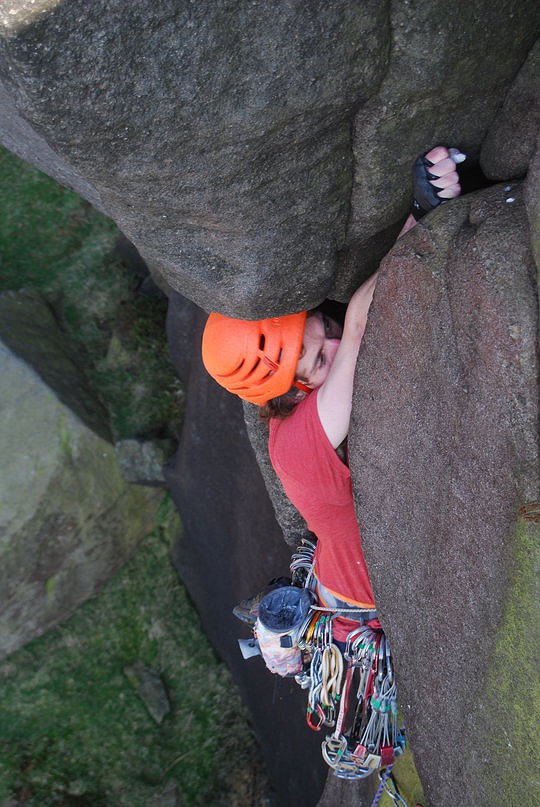

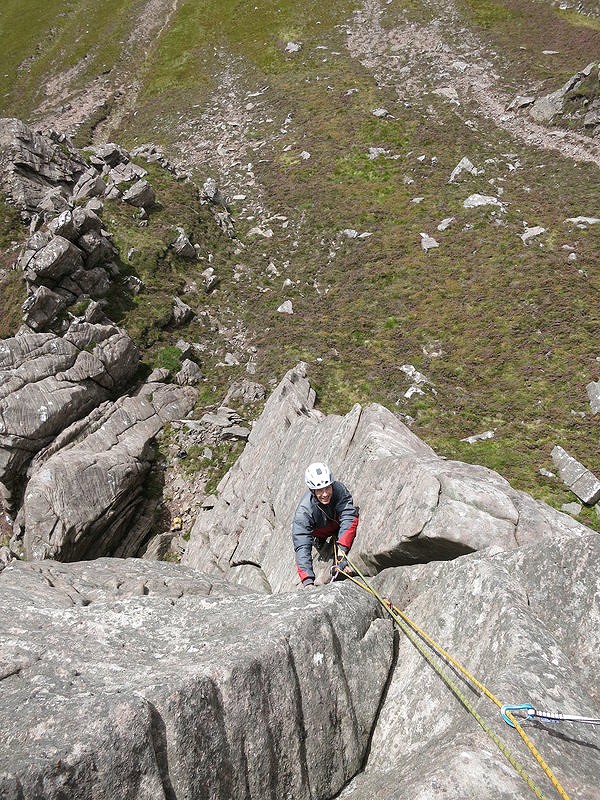
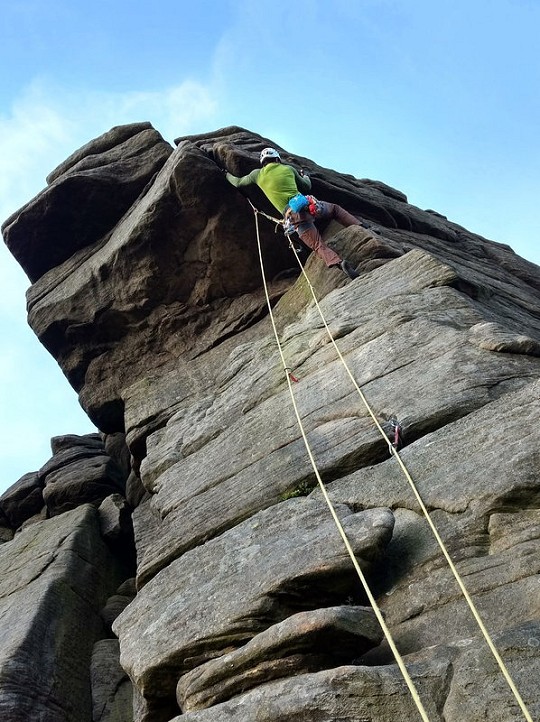


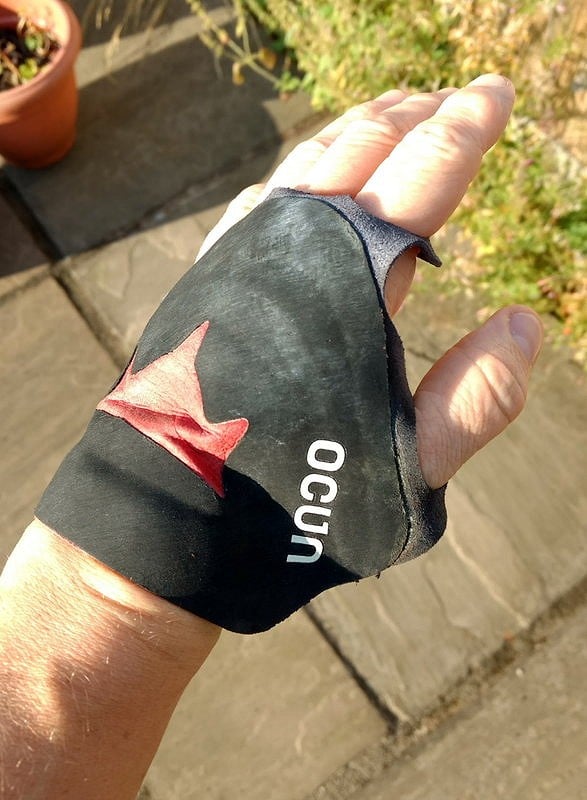
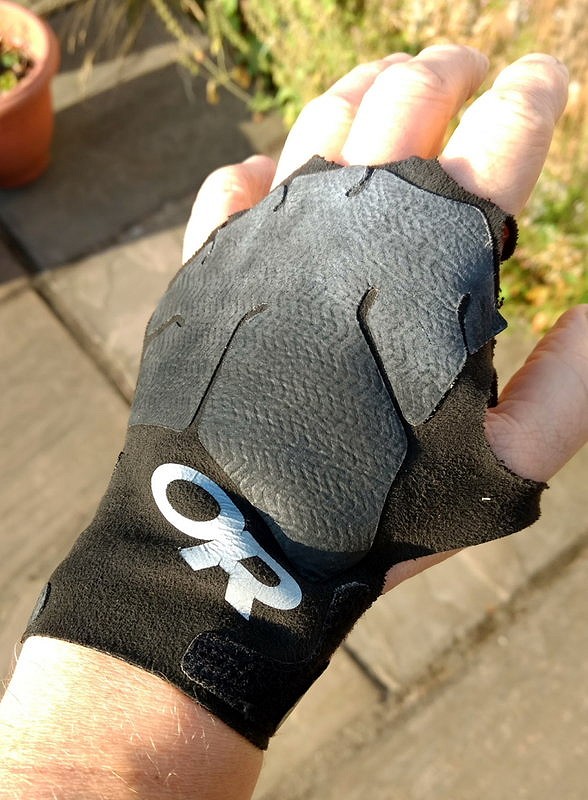
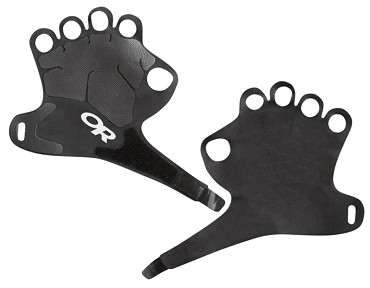
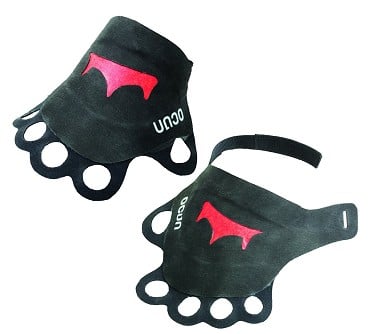

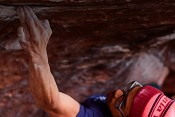


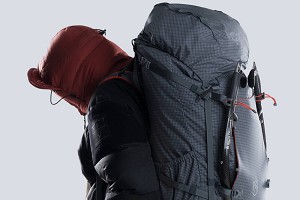



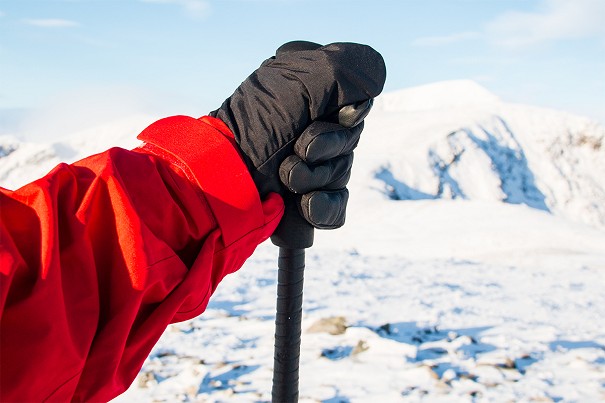
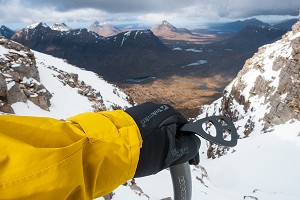





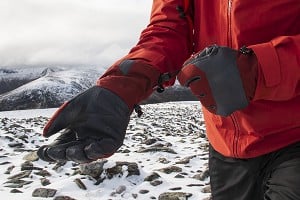
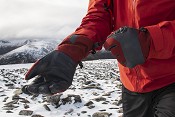
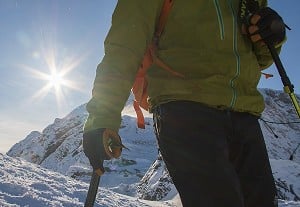

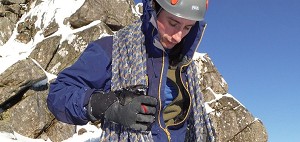

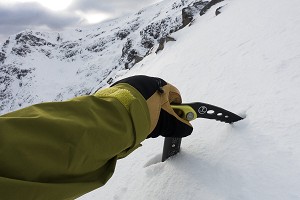

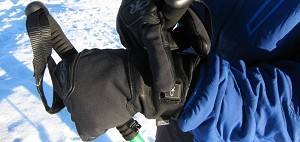

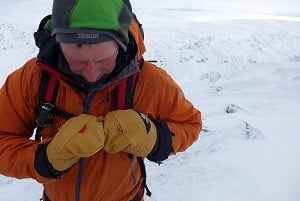
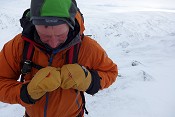
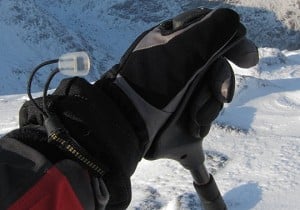
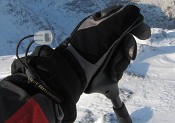
Comments